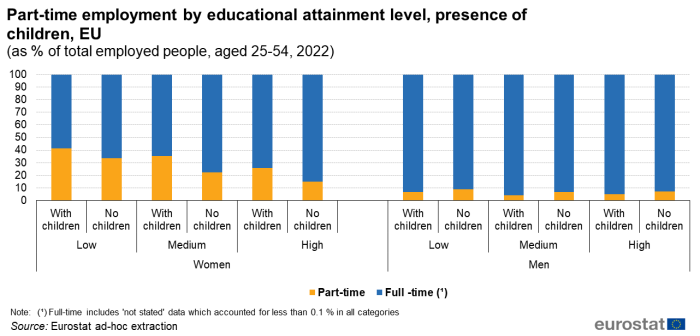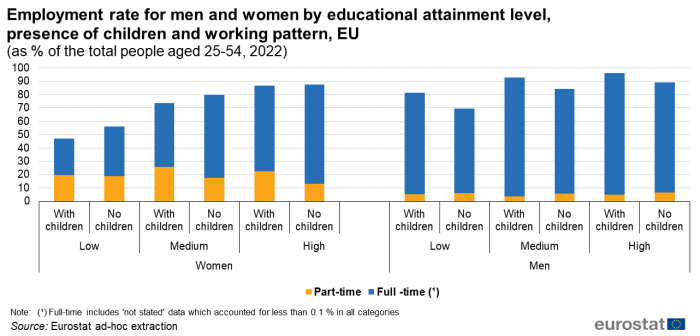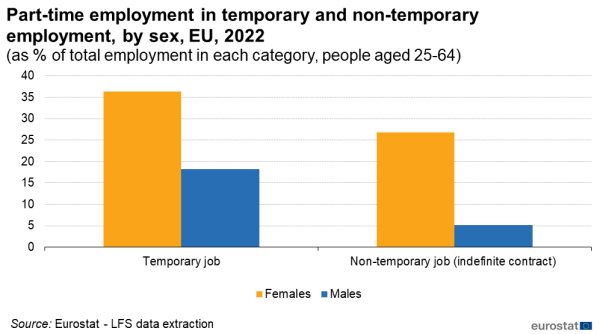Part-time and full-time employment - statistics
Data from May 2023
Planned article update: June 2024
Highlights
In 2022, 17 % of employed people were part-timers, the lowest share recorded in the EU since 2009.
In the EU, 41 % of employed women aged 55-64 with a low level of education worked part-time in 2022.
More than 60 % of employed women with children worked part-time in the EU in 2022, with highest shares in the Netherlands (69 %), Austria (69 %) and Germany (65 %).
Trend in part-time employment, EU, 2009-2022
This article presents the most recent insights into part-time employment based on the EU Labour Force Survey (LFS). It provides information about the trend in part-time employment and the profile of part-time workers in terms of sex, age, level of education and occupation. Other areas of focus include the presence of children in the household. The results are presented at EU level and by EU country.
Full article
Main concept
In the context of the EU Labour Force Survey, data on part-time employment is only collected about the main job of a person who is in work. This main job can be either a full-time job or a part-time job. The distinction is based on the respondent's own perception of the usual hours worked in the main job. It is therefore based on people's own assessment of their situation. A person in a part-time job is assumed to work less than a comparable full-time worker having a job in the same occupation and in the same organisation ('local unit'). For people who can't compare working hours because e.g. they are working alone, the benchmark is the group of people who work in the same occupation and the same branch of industry in the same country.
In 2022, reasons given by part-time workers aged 25-64 for being employed under such working-time arrangements were significantly different for women and men. They included:
- care of adults with disabilities or children (29.2 % of female part-timers against 7.7 % of male part-timers)
- no full-time job found (19.2 % for women against 29.6 % for men)
- other family reasons (7.1 % for women against 2.7 % for men)
- own illness or disability (5.5 % for women against 10.8 % for men) and
- education or training (3.1 % for women against 9.0 % for men).
Only the category of 'other personal and non-personal reasons' showed roughly the same shares for women (35.7 %) and men (40.1 %).
Developments for part-time workers
Downward trend in part-time employment since 2016
After increasing significantly between 2009 and 2013, the share of part-timers in total employed people aged 20-64 declined slightly in the following 5 years (2013-2018) from 19.1 % in 2013 to 18.7 % in 2018 and remained stable in 2019. In 2020, when the COVID-19 pandemic hit the EU labour market, the share of part-timers decreased to 17.3 % and started to fall slightly again, reaching 17.0 % in 2022. However, part-time employment is uneven between women and men, accounting for 27.8 % of employed women in 2022 versus 7.6 % of employed men (see Figure 1). The increase in part-time employment between 2009 and 2013 was roughly the same for women and men. However, the share for female part-timers had already registered a downward trend from 2013 while the trend for men was more stable over the whole period 2013-2022.
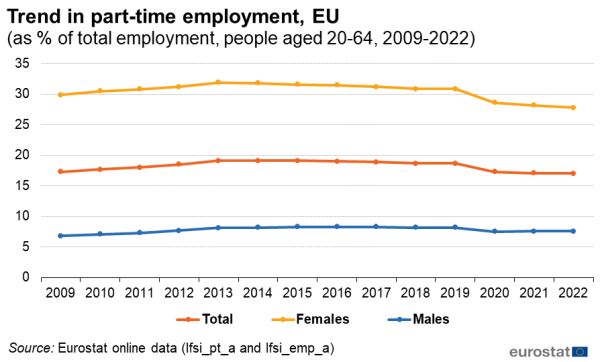
(as % of total employment people aged 20-64, 2009-22)
Source: Eurostat (lfsi_pt_a) and (lfsi_emp_a)
Figure 2 compares the annual changes in part-time and full-time employment in the EU since 2009. A comparison of annual changes to both categories over 2009-2022 indicates that between 2009 and 2013, the number of part-timers recorded an increase while the number of full-timers recorded a decrease. From 2013 to 2022, the change was positive for both categories except in 2018 and 2020. In 2018, the number of part-timers dropped by 1.0 % and the number of full-timers recorded an increase of 1.4 %. In 2020, during the health crisis, the number of part-timers fell by 9.4 % while full-time employment increased by 0.1 %. In 2021 and 2022, although part-time and full-time employment increased, the increase was higher for full-timers (+1.6 % in 2021 and +2.3 % in 2022) than for part-timers (+0.8 % in 2021 and +1.0 % in 2022).
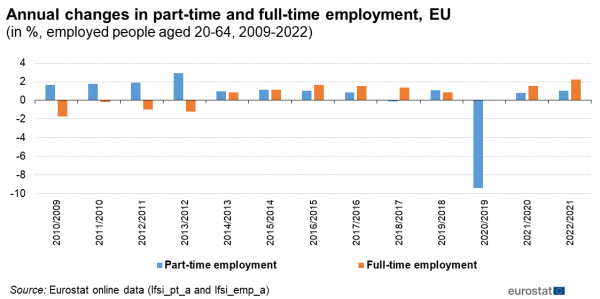
(in %, employed people aged 20-64, 2009-22)
Source: Eurostat (lfsi_pt_a) and (lfsi_emp_a)
Worker profile and countries
More part-time employment among women and young people
Looking at age, sex and level of education, part-time workers are more likely to be younger, female and with a lower educational level.
- Younger people aged 15-24 are generally more likely to work part-time (see Figure 3). This specific age group is not broken down by educational attainment level but by participation in formal educational and training to distinguish those working and studying and those who are no longer in education. Making this distinction is crucial when analysing youth part-time employment. Indeed, slightly more than half of employed people aged 15-24 and still in education (54.0 %) were part-timers in 2022 (60.0 % for women and 48.0 % for men). Of those in this age group but not participating in education, 16.7 % were working part-time (23.8% for women and 11.7% for men). The share of those aged 25-54 was close (15.3 %) but the difference between women and men was wider (25.9 % for women and 6.1% for men). Interestingly, the share of part-timers in total employed people aged 55-64 was higher in comparison with those aged 25-54 for the total category (19.7 %) and for both women (32.6 %) and men (8.6 %).
- On level of education, people aged 25-54 as well as those aged 55-64 show the same pattern. Among employed women, the higher the level of education, the lower the share of part-timers with significant differences. To illustrate this, 37.8 % of employed women aged 25-54 with a low level of education were part-time workers in 2022 against 28.7 % for those with a medium level of education and 20.7 % for those with a high level of education. Men were less likely to work part-time and differences by level of education were not so pronounced. In all educational categories, the share of male part-timers was below 10 %. The lowest were reported by men aged 25-54 with a medium level of education (5.3 %) and the highest by men aged 55-64 with a low level of education (9.2 %).
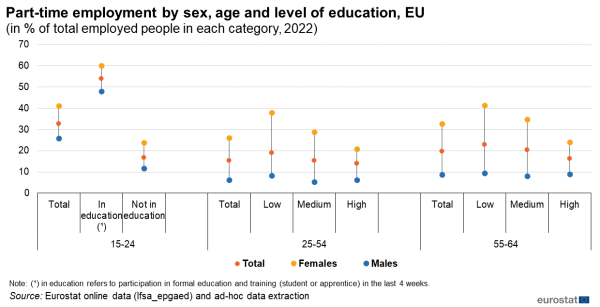
(as % of total employed people in each category, 2022)
Source: Eurostat (lfsa_epgaed) and ad-hoc data extraction
In 2022, 17.0 % of employed people were working part-time. At EU level as well as in all EU countries except Romania, females were more likely to be in this category (27.8 %) than men (7.6 %). More than 1 in 5 employed people were working part-time in the Netherlands 38.4 %, Austria (30.1 %), Germany (27.9 %), Belgium (23.0 %) and Denmark (20.9 %). In the four first countries, more than one third of employed women worked part-time in 2022: 60.6 % in the Netherlands, 51.0 % in Austria, 47.3 % in Germany and 37.5 % in Belgium. These countries also recorded the widest differences between women and men. The lowest shares were found in Bulgaria, Slovakia and Romania where less than 4 % of employed people were part-timers and less than 5 % of employed women.
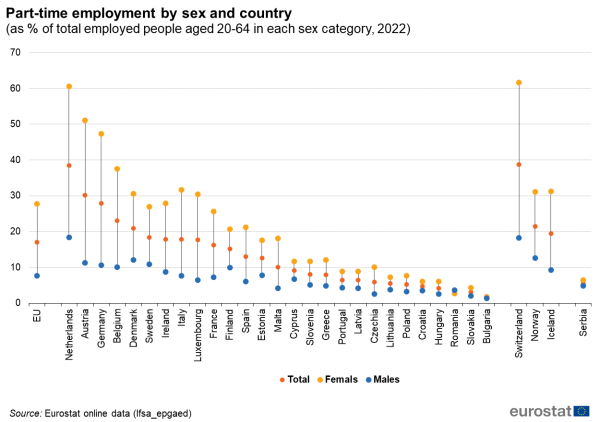
(as % of total employed people aged 20-64 in each sex category, 2022)
Source: Eurostat (lfsa_epgaed)
Part-time employment and children
In the EU, 1 in 3 employed women with children worked part-time in 2022
Figure 5 presents the share of part-time employment in total employment for men and women aged 25-54, either with or without children. In 2022, almost one third of employed women aged 25-54 years with children worked on a part-time basis in the EU (31.5 %) against 20.2 % among employed women without children. For men, it is the opposite: fewer employed men with children worked part-time (4.9 %) compared with men without children (7.2 %). The proportion of employed women with children working part-time was higher than the proportion of women without children working part-time in all countries except Denmark, Greece, Portugal and Lithuania.
The share of part-timers differs greatly between men and women across EU countries and the gender gap (i.e. the difference between the female and the male share of part-time employment in total employment) becomes even wider when people have children. In 2022, the gender gap in part-time employment rates between men with children and women with children was 26.6 pp. in the EU. For men and women without children, the gap was narrower and amounted to less than half of the gap observed for people with children (13.0 pp.).
In Bulgaria, Romania, Slovakia, Croatia, Lithuania, Hungary, Portugal, Poland and Latvia, the proportion of part-time workers in total employment was relatively low regardless of the presence of children and was lower than 10 % for employed men or employed women, with or without children.
Moreover, the share of men working part-time with or without children does not fluctuate as much as the share of women employed part-time across EU countries. The male share was between 14.5 % (for men without children in the Netherlands) and 1.3 % (for men either with or without children in Bulgaria and men with children in Hungary).
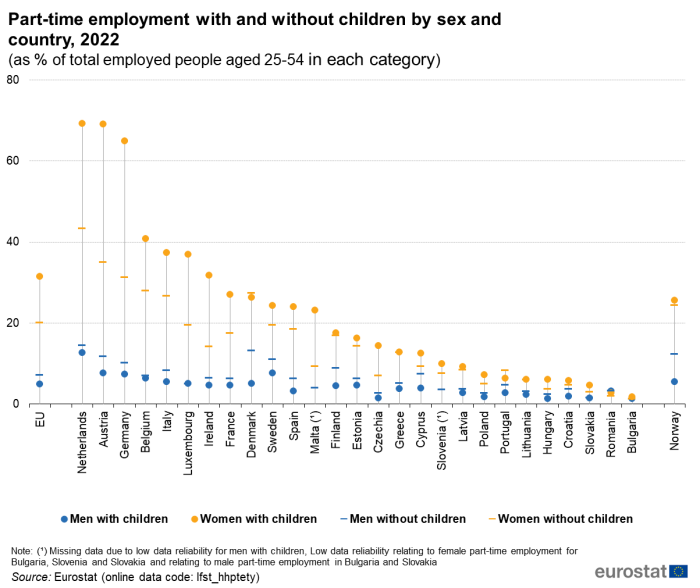
(as % of total employed people aged 25-54 in each category)
Source: Eurostat (lfst_hhptety)
Figure 6 highlights the impact of having children on the female vs male employment rate and on the female vs male share of part-time employment in total employment. At EU level, the employment rate for women aged 25-54 with children in 2022 was 73.7 %, which is 5.0 pp. lower than the employment rate for women aged 25-54 without children. Among employed women, the share of part-time employment reached 31.5 % which is 11.3 pp. higher than women without children. For men, it is the opposite, the employment rate for men aged 25-54 with children was 91.0 % (8.5 pp. higher than men without children) and the share of part-time employment among those with children was 2.3 pp. lower than for men without children.
Comparing the differences recorded for the 2 indicators at national level shows that the presence of children may be reflected, according to the countries, either only in the employment rate, only in the share of part-time employment, in both or in any.
- In 21 out of 27 EU countries, the employment rate for women with children aged 25-54 was below the employment rate for women without children. The largest difference was found in Czechia (-18.7 pp.). Women with children had a higher employment rate than those without children in only 6 EU countries for example Sweden (+10.3 pp.).
- In 23 out of 27 EU countries, the share of part-time employment for women with children aged 25-54 was higher than the share of part-time employment for women without children. This gap is particularly visible and above 20 pp.in Austria (+34.0 pp.) and Germany (+33.5 pp.) and the Netherlands (25.8 pp.).
- Interestingly, in some countries, significant changes in both indicators (i.e. a drop in the employment rate and increase in the share of part-time employment) occur, e.g. in Germany, Ireland, Malta and Czechia. By contrast, there are no visible differences between women with and without children for both indicators in Croatia, Slovenia, Portugal, Finland, Lithuania and Greece.
- In some other countries, there are differences between those with and without children, but only in one of the two indicators. For example, in the Netherlands, Luxembourg and Belgium, the share of part-time employment for women with children was significantly higher (more than 10 pp.) than the share of part-time employment for women without children while the employment rates did not show a difference larger than 4 pp. between both categories (i.e. women with and without children). Romania and Slovakia were examples where the employment rate for women with children was significantly below the rate for women without children (respectively, 9.3 pp. and 6.8 pp.), but no significant differences in the share of part-time employment were recorded.
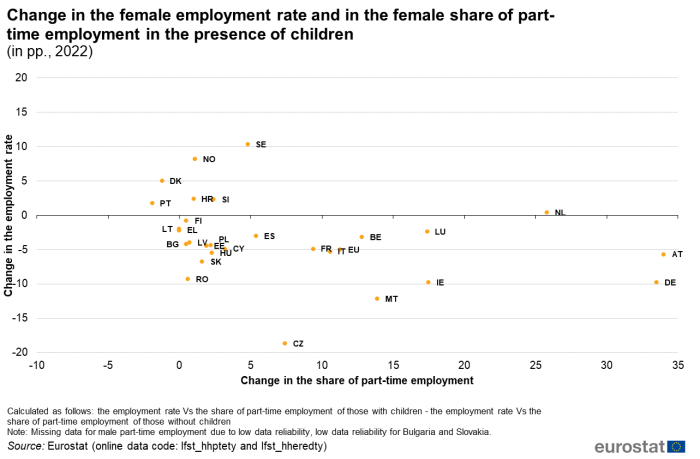
Source: Eurostat (lfst_hhptety) and (lfst_hheredty)
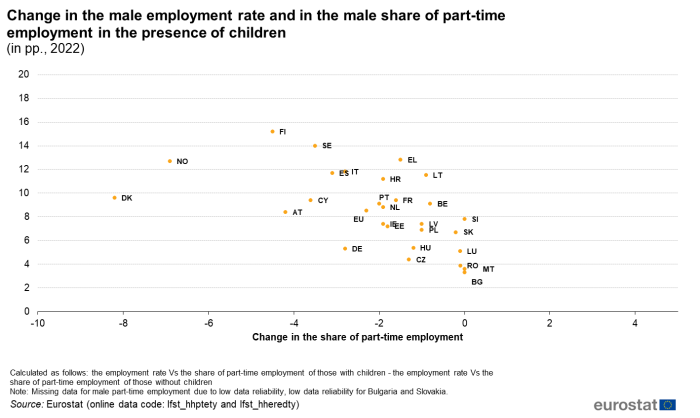
Source: Eurostat (lfst_hhptety) and (lfst_hheredty)
Concerning men, by contrast, having children indicates a higher employment rate in all countries with Finland and Sweden recording the largest differences (+15.2 pp. and +14.0 pp.), followed by Greece (+12.8 pp.), Italy (+11.8 pp.) and Spain (+11.7 pp.). The results also show a stable or a lower share in part-time employment for men with children compared to those without children in all countries for which data is available.
Impact of the level of education for part-timers with children
The higher the level of education, the higher the level of part-time employment of those with children
Figure 7 presents the share of part-time and full-time employment by sex, level of education and presence of children in the household among employed people aged 25-54. The share of women working part-time in the female employment was the highest for women with a low level of education and with children (41.6 %) followed by women with a medium level of education and having children (35.2 %) and women with a low level of education and without children (33.5 %). By contrast, it was the lowest for women without children with a high level of education (14.8 %). The gap between the share of part-time employment for employed women with and without children was the largest for women with a medium level of education (+13.0 pp.). The corresponding gap for women with a high level of education was slightly smaller (+11.1 pp.) whereas the gap for women with a low level of education was 8.0 pp.
For men, the results differ greatly. The share of male part-time employment in total male employment was the highest for men with a low level of education and with no children (8.9 %) in 2022. The lowest share was recorded for men with a medium level of education and with children (4.0 %). The gap between the share of part-time employment for men with and without children by level of education was much smaller than for women. The gap for men with a medium level of education was -2.6 pp. whereas the gap for men with a low and high level of education was -2.2 pp. for both categories.
Considering Figure 8, which shows the employment rate of the same categories as above broken down by working pattern, the employment rate for women with a high level of education seems to be less affected by the presence of children (-1.1 pp. compared with those who have no children) than the employment rate for women with a low level of education (-9.3 pp.) or with a medium level of education (-6.2 pp.). However, employed women working part-time with a medium and a high level of education were more affected by the presence of children (+11.1 pp. and +13.0 pp.) than women with a low level of education as mentioned above (+8.0 pp.).
Part-time employment by occupation
Figure 9 compares the share of part-time workers in total employment by sex and by main ISCO-08 occupational categories.
In 2022, almost half of employed women in elementary occupations (entailing simple and routine tasks and mainly requiring the use of hand-held tools and some physical effort) were working part-time (46.8 %) against 15.9 % of employed men in the same category of occupations. More than one third of female workers were part-timers (34.2 %) in services and sales compared with 13.5 % of male employed people. These workers provide personal and protective services related to travel, housekeeping, catering, personal care, protection against fire and unlawful acts, or demonstrate and sell goods. At the other end of the scale, fewer than 6 % of people in work were part-timers in the following occupation categories: craft and related trades (4.9 %), managers (5.3 %) and plant and machine operators and assemblers (5.9 %). In these 3 categories, less than 20 % of women were working part-time (respectively, 16.2 %, 9.8 % and 12.6%).
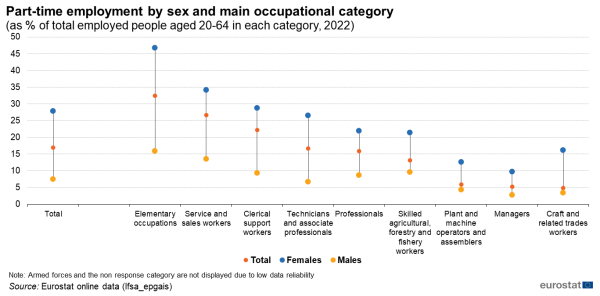
(as % of total employed people aged 20-64 in each category, 2022)
Source: Eurostat (lfsa_epgais)
Temporary contracts and part-time employment
It is worth highlighting that, at EU level, the share of people working part-time under temporary contracts was higher than those working under an indefinite contract. Among female temporary workers, 36.3% were working part-time in 2022 against 26.7 % among those working with an indefinite contract. The difference is even more visible among men: 18.2 % of temporary workers were working part-time against only 5.2 % of men who had an indefinite contract.
Source data for tables and graphs
Data sources
Source: The European Union Labour Force Survey (EU-LFS) is the largest European household sample survey and provides quarterly and annual results on labour participation by people aged 15 and over as well as data on people outside the labour force. It covers residents in private households. Conscripts in military or community service are not included in the results. The survey is based on the same target populations and uses the same definitions in all countries, which means that the results are comparable between countries.
Reference period: Yearly results are obtained as averages of the four quarters in the year.
Coverage: The results from the survey currently cover all European Union countries, the EFTA countries Iceland, Norway, Switzerland and the candidate countries Montenegro, North Macedonia, Serbia and Türkiye. For Cyprus, the survey covers only the areas of Cyprus controlled by the Government of the Republic of Cyprus.
European aggregates: EU refers to the sum of current EU-27 countries. If data are unavailable for a country, the calculation of the corresponding aggregates takes into account the data for the same country for the most recent period available. Such cases are indicated.
Definitions: The concepts and definitions used in the survey follow the guidelines of the International Labour Organisation. Employment covers people:
- aged 15 years and over (16 and over in Spain and Italy, 15-74 years in Estonia, Latvia, Hungary, Finland, Sweden, Norway and Denmark, and 16-74 years in Iceland)
- living in private households
- who performed work during the reference week, even for just one hour, for pay, profit or family gain, or
- who were not at work but had a job or business from which they were temporarily absent, for example because of illness, holidays, industrial dispute or education and training.
Employment can be measured in terms of the number of people or jobs, in full-time equivalents or in hours worked. All the estimates presented in this article use the number of people; the information presented for employment rates is also built on estimates for the number of people. Employment statistics are frequently reported as employment rates to discount the changing size of countries’ populations over time and to facilitate comparisons between countries of different sizes. These rates are typically published for the working age population, which is generally considered to be those aged between 15 and 64 years, although the age range of 16 to 64 is used in Spain and Iceland. The 15 to 64 years age range is also a standard used by other international statistical organisations (although the age range of 20 to 64 years is given increasing prominence by some policymakers as a rising share of the EU population continue their studies into tertiary education).
The LFS employment concept differs from national accounts domestic employment, as the latter sets no limit on age or type of household, and also includes the non-resident population contributing to GDP and conscripts in military or community service.
Five different articles on detailed technical and methodological information are linked from the overview page EU labour force survey.
Please note that Eurostat provides two sets of indicators linked to the annual employment rate, which serve different purposes and which in some cases differ from each other:
1) The main indicators, which are seasonally adjusted. They include the headline indicators under the EU2020 Strategy which are used to monitor the EU 2020 targets (at EU and national levels). They have only a few breakdowns and normally refer to the age group 20-64. Please note that for France, two series are published: one including overseas departments starting in 2003, and one for metropolitan France, excluding overseas departments, starting in 1992. The Metropolitan France series is evaluated in the EU2020 strategy, and also included in the relevant EU and EA aggregates.
2) The detailed results, which are not seasonally adjusted. They have a large number of breakdowns and can therefore be used for more detailed analysis. For France, only one data series is published. This series contains data for metropolitan France only until the fourth quarter of 2013. From 2014, they also include the French overseas departments.
This article presents annual results for most indicators from the "main indicators" set.
Main concepts: Some main employment characteristics, as defined by the EU Labour Force Survey, include:
- employees defined as those who work for a public or private employer and who receive compensation in the form of wages, salaries, payment by results, or payment in kind; this category includes non-conscript members of the armed forces;
- self-employed persons work in their own business, farm or professional practice. A self-employed person is considered to be working during the reference week if she/he meets one of the following criteria: works for the purpose of earning profit; spends time on the operation of a business; or is currently establishing a business;
- the distinction between full-time and part-time work is generally based on the spontaneous response of respondents. The main exceptions are the Netherlands and Iceland where a 35 hours limit is applied, Sweden where a limit is applied to the self-employed, and Norway where people working between 32 and 36 hours are asked whether this is a full- or part-time position;
- indicators for employed persons with a second job refer only to people with more than one job at the same time; people having changed job during the reference week are not counted as having two jobs;
- an employee is considered as having a temporary job if employer and employee agree that the end of the job is determined by objective conditions, such as a specific date, the completion of an assignment, or the return of an employee who is being temporarily replaced. Typical cases include: people in seasonal employment; people engaged by an agency or employment exchange and hired out to a third party to perform a specific task (unless there is a written work contract of unlimited duration); people with specific training contracts.
Level of education refers to the educational attainment level, i.e. the highest level of education successfully completed.
- Low level of education refers to ISCED levels 0-2 (less than primary, primary and lower secondary education),
- Medium level refers to ISCD levels 3 and 4 (upper secondary and post-secondary non-tertiary education)
- High level refers to ISCED levels 5-8 (tertiary education).
Context
Employment statistics can be used for a number of different analyses, including macroeconomic (looking at labour as a production factor), productivity or competitiveness studies. They can also be used to study a range of social and behavioural aspects related to an individual's employment situation, such as the social integration of minorities, or employment as a source of household income.
Employment is both a structural indicator and a short-term indicator. As a structural indicator, it may shed light on the structure of labour markets and economic systems, as measured through the balance of labour supply and demand, or the quality of employment. As a short-term indicator, employment follows the business cycle; however, it has limits in this respect, as employment is often referred to as a lagging indicator.
Employment statistics are at the heart of many EU policies. The European Pillar of Social Rights has been jointly signed by the European Parliament, the Council and the Commission on 17 November 2017. Employment and social policies are the main fields of interest of the European Pillar of Social Rights, which is about delivering new and more effective rights for citizens. It has 3 main categories: (1) Equal opportunities and access to the labour market, (2) Fair working conditions and (3) Social protection and inclusion. In particular, today's more flexible working arrangements provide new job opportunities especially for the young but can potentially give rise to new precariousness and inequalities. Building a fairer Europe and strengthening its social dimension is a key priority for the Commission. The European Pillar of Social Rights is accompanied by a 'social scoreboard' which will monitor the implementation of the Pillar by tracking trends and performances across EU Member States in 12 areas and will feed into the European Semester of economic policy coordination. The scoreboard will also serve to assess progress towards a social 'triple A' for the EU as a whole.
The action plan presented by the Commission in March 2021 provides guidance on the implementation of the European pillar of social rights, including in the areas of employment, skills and social protection. The action plan also sets three main targets to be achieved throughout the European Union by 2030:
- an employment rate of at least 78 % in the EU;
- at least 60 % of adults attending training courses every year;
- a reduction of at least 15 million in the number of people at risk of social exclusion or poverty.
In June 2022, EU employment and social affairs ministers presented their national targets to deliver on the European Pillar of Social Rights Action Plan by 2030. For more information, see the dedicated section on the European Commission website.
Furthermore, the European Employment Strategy (EES) dates back to 1997, now constitutes part of the Europe 2020 growth strategy. It is implemented through the European semester, an annual process promoting close policy coordination among EU Member States and EU Institutions. In particular, the implementation of the EES - supported by the work of the Employment committee - involves the following four steps of the European Semester:
- Employment guidelines are common priorities and targets for employment policies proposed by the Commission, agreed by national governments and adopted by the EU Council.
- The Joint employment report (JER) is based on (a) the assessment of the employment situation in Europe (b) the implementation of the Employment Guidelines and (c) an assessment of the Scoreboard of key employment and social indicators. It is published by Commission and adopted by the EU Council.
- National Reform Programmes (NRPs) are submitted by national governments and analysed by the Commission for compliance with Europe 2020. (database – NRPs prior to 2011)
- Based on the assessment of the NRPs the Commission publishes a series of Country reports, analysing Member States' economic policies and issues Country-specific recommendations.
Direct access to
- LFS main indicators (t_lfsi)
- Population, activity and inactivity - LFS adjusted series (t_lfsi_act)
- Employment - LFS adjusted series (t_lfsi_emp)
- Unemployment - LFS adjusted series (t_une)
- LFS series - Detailed annual survey results (t_lfsa)
- LFS series - Specific topics (t_lfst)
- LFS main indicators (lfsi)
- Employment and activity - LFS adjusted series (lfsi_emp)
- Unemployment - LFS adjusted series (une)
- Labour market transitions - LFS longitudinal data (lfsi_long)
- LFS series - Detailed quarterly survey results (from 1998 onwards) (lfsq)
- LFS series - Detailed annual survey results (lfsa)
- LFS series - Specific topics (lfst)
- LFS ad-hoc modules (lfso)
Publications
- Labour force survey in the EU, EFTA and candidate countries — Main characteristics of national surveys, 2020, 2022 edition
- Quality report of the European Union Labour Force Survey 2020, 2022 edition
- EU labour force survey — online publication
ESMS metadata files and EU-LFS methodology
- Employment and unemployment (Labour Force Survey) (ESMS metadata file — employ_esms)
- LFS main indicators (ESMS metadata file — lfsi_esms)
- LFS series - detailed annual survey results (ESMS metadata file — lfsa_esms)
- LFS series - detailed quarterly survey results (from 1998 onwards) (ESMS metadata file — lfsq_esms)
- LFS regional series (ESMS metadata file — reg_lmk)
- LFS ad-hoc modules (ESMS metadata file — lfso_esms)
